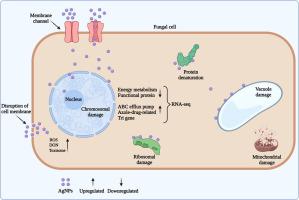Journal of Advanced Research ( IF 10.7 ) Pub Date : 2021-09-17 , DOI: 10.1016/j.jare.2021.09.006 Yunqing Jian 1 , Xia Chen 1 , Temoor Ahmed 1 , Qinghua Shang 1 , Shuai Zhang 2 , Zhonghua Ma 1 , Yanni Yin 1

|
Introduction
Fusarium graminearum is a most destructive fungal pathogen that causes Fusarium head blight (FHB) disease in cereal crops, resulting in severe yield loss and mycotoxin contamination in food and feed. Silver nanoparticles (AgNPs) are extensively applied in multiple fields due to their strong antimicrobial activity and are considered alternatives to fungicides. However, the antifungal mechanisms and the effects of AgNPs on mycotoxin production have not been well characterized.
Objectives
This study aimed to investigate the antifungal activity and mechanisms of AgNPs against both fungicide-resistant and fungicide-sensitive F. graminearum strains, determine their effects on mycotoxin deoxynivalenol (DON) production, and evaluate the potential of AgNPs for FHB management in the field.
Methods
Scanning electron microscopy (SEM), transmission electron microscopy (TEM), and fluorescence microscopy were used to examine the fungal morphological changes caused by AgNPs. In addition, RNA-Seq, qRT-PCR, and western blotting were conducted to detect gene transcription and DON levels.
Results
AgNPs with a diameter of 2 nm exhibited effective antifungal activity against both fungicide-sensitive and fungicide-resistant strains of F. graminearum. Further studies showed that AgNP application could impair the development, cell structure, cellular energy utilization, and metabolism pathways of this fungus. RNA-Seq analysis and sensitivity determination revealed that AgNP treatment significantly induced the expression of azole-related ATP-binding cassette (ABC) transporters without compromising the control efficacy of azoles in F. graminearum. AgNP treatment stimulated the generation of reactive oxygen species (ROS), subsequently induced transcription of DON biosynthesis genes, toxisome formation, and mycotoxin production.
Conclusion
This study revealed the underlying mechanisms of AgNPs against F. graminearum, determined their effects on DON production, and evaluated the potential of AgNPs for controlling fungicide-resistant F. graminearum strains. Together, our findings suggest that combinations of AgNPs with DON-reducing fungicides could be used for the management of FHB in the future.
中文翻译:

纳米银对产霉菌禾谷镰刀菌的毒性及作用机制
介绍
禾谷镰刀菌是一种最具破坏性的真菌病原体,可在谷类作物中引起枯萎病(FHB)病害,导致严重的产量损失和食品和饲料中的霉菌毒素污染。银纳米粒子 (AgNPs) 因其强大的抗菌活性而被广泛应用于多个领域,被认为是杀菌剂的替代品。然而,AgNPs 的抗真菌机制和对霉菌毒素产生的影响尚未得到很好的表征。
目标
本研究旨在研究 AgNPs 对抗杀菌剂和对杀菌剂敏感的禾谷镰刀菌菌株的抗真菌活性和机制,确定它们对霉菌毒素脱氧雪腐镰刀菌烯醇 (DON) 产生的影响,并评估 AgNPs 在该领域管理 FHB 的潜力。
方法
扫描电子显微镜 (SEM)、透射电子显微镜 (TEM) 和荧光显微镜用于检查 AgNPs 引起的真菌形态变化。此外,还进行了 RNA-Seq、qRT-PCR 和蛋白质印迹以检测基因转录和 DON 水平。
结果
直径为 2 nm 的 AgNPs 对禾谷镰刀菌的杀菌剂敏感菌株和杀菌剂耐药菌株均表现出有效的抗真菌活性。进一步的研究表明,AgNP 的应用可能会损害这种真菌的发育、细胞结构、细胞能量利用和代谢途径。RNA-Seq 分析和敏感性测定表明,AgNP 处理显着诱导唑类相关 ATP 结合盒 (ABC) 转运蛋白的表达,而不会影响唑类对禾谷镰刀菌的控制效果。AgNP 处理刺激了活性氧 (ROS) 的产生,随后诱导了 DON 生物合成基因的转录、毒物体的形成和霉菌毒素的产生。
结论
本研究揭示了 AgNPs 对抗禾谷镰刀菌的潜在机制,确定了它们对 DON 产生的影响,并评估了 AgNPs 在控制抗杀菌剂禾谷镰刀菌菌株方面的潜力。总之,我们的研究结果表明,AgNPs 与减少 DON 的杀菌剂的组合可用于未来 FHB 的管理。


























 京公网安备 11010802027423号
京公网安备 11010802027423号